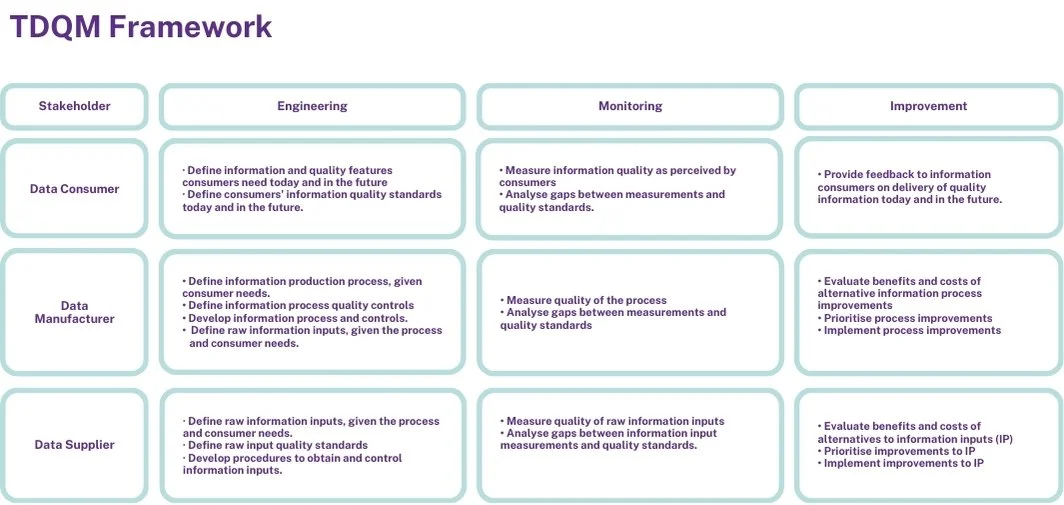Why TDQM Matters for DRL Progression and AI Readiness
Traditional data quality approaches address issues reactively, when reports don't match, when analytics fail, when AI models produce unreliable results. This reactive approach keeps organisations stuck at lower DRL levels, where data quality problems constantly impede progress. TDQM provides the systematic, proactive approach required to achieve and sustain DRL 7 and beyond.
Connection to DRL Maturity:
DRL Levels 1-3 (Foundation): Limited or no systematic quality management. Issues addressed when discovered. No defined quality standards or processes.
DRL Levels 4-5 (Capability): Beginning to define quality requirements and implement basic monitoring. Reactive improvement still common.
DRL Levels 7+ (Maturity): Full TDQM lifecycle implemented across all stakeholders. Quality engineered into systems, continuously monitored, and systematically improved. This is the hallmark of DRL 7.
Connection to Predictive People Analytics and AI ROI:
Quality at source: TDQM's focus on supplier quality standards prevents the data quality issues that cause 85% of AI project failures
Process reliability: TDQM's manufacturer focus ensures infrastructure consistently delivers quality data, enabling reliable model training
Fitness for purpose: TDQM's consumer focus ensures data products meet analytical requirements, accelerating time-to-insight by 60-80%
Continuous improvement: TDQM's lifecycle approach sustains quality as analytical needs evolve, protecting AI investments long-term
The TDQM framework provides the DPM with systematic methods for operationalising the quality management required at DRL 7, ensuring that Predictive People Analytics and AI initiatives have the reliable data foundation they require to deliver expected ROI.
Understanding the TDQM Framework Structure
The TDQM framework provides specific guidance for each stakeholder across the quality management lifecycle. While the complete framework details extensive processes for each phase and stakeholder, the core structure demonstrates the systematic thinking shift from by-product to product management:
For Data Consumers (Analytics Teams):
Engineering: Define what quality means for analytical consumption, including accuracy, completeness, timeliness, consistency
Monitoring: Measure whether received data meets quality standards in practice
Improvement: Provide feedback driving quality improvements in manufacturing and supply processes
For Data Manufacturers (IT/Engineering Teams):
Engineering: Design production processes that systematically create quality data products
Monitoring: Measure whether processes are operating within quality parameters
Improvement: Continuously enhance processes to improve quality and efficiency
For Data Suppliers (Data Creators):
Engineering: Define collection and input quality standards and implement controls at source
Monitoring: Measure quality of data creation against standards
Improvement: Systematically improve data collection and input processes and compliance
The By-Product to Product Thinking Shift:
Each TDQM responsibility framework illustrates this fundamental transition:
By-Product Approach (Lower DRL levels):
No defined quality standards: quality is subjective and inconsistent
Reactive monitoring only when problems surface
Improvement happens through firefighting, not systematic process enhancement
Each stakeholder group operates independently with no quality feedback loops
Quality seen as cost centre, not value enabler
Product Approach (DRL 7+ via TDQM):
Clear quality standards defined and documented for all stakeholders
Continuous monitoring providing early warning of quality degradation
Systematic improvement based on data-driven gap analysis
Stakeholder groups operate as integrated quality management system
Quality understood as foundational to analytical ROI and competitive advantage
The TDQM framework doesn't just describe these differences, it provides the systematic processes for implementing product thinking across the organisation, enabling sustainable DRL 7 maturity.
How the DPM Uses TDQM as a Systematic Toolkit
The Data-as-a-Product Manager leverages TDQM as an operational toolkit for implementing quality management across all stakeholders:
Phase 1: Engineering (Defining Quality)
Use TDQM to establish clear quality standards for data consumers, processes for data manufacturers, and inputs for data suppliers
Align quality definitions across stakeholders ensuring consistency
Document quality requirements mapped to analytical use cases and DRL 7 criteria
Phase 2: Monitoring (Measuring Quality)
Implement TDQM monitoring processes tracking quality metrics for each stakeholder
Establish early warning systems preventing quality degradation
Phase 3: Improvement (Enhancing Quality)
Use TDQM improvement processes to systematically address quality gaps
Prioritise improvements delivering maximum impact on DRL progression
Create feedback loops ensuring all stakeholders learn from quality issues
Continuous Cycle:
TDQM operates as continuous cycle, not one-time project
Standards evolve as analytical requirements advance
Quality management becomes embedded organisational capability
The Integration with DPM Responsibility Frameworks:
The DPM Responsibility Frameworks (Data Consumer, Data Manufacturer, Data Supplier) define WHAT each stakeholder needs and the thinking shift required. TDQM defines HOW to systematically achieve and maintain the quality those frameworks require. Together, they provide comprehensive toolkit for achieving DRL 7:
Responsibility Frameworks: Diagnose current state, identify gaps, define target state
TDQM: Operationalise quality management through systematic lifecycle processes
Combined: Enable systematic progression from lower DRL levels to sustained DRL 7 maturity
TDQM as the Operational Framework for DRL 7 Quality Management
The Total Data Quality Management framework provides organisations with a proven, systematic approach to achieving the quality management maturity that defines DRL 7. By implementing TDQM's lifecycle processes across Data Consumer, Manufacturer, and Supplier stakeholders, the DPM operationalises the thinking shift from data by-product to data product.
Key principles:
Lifecycle approach: Quality is engineered, monitored, and continuously improved, not addressed reactively
Stakeholder integration: All three perspectives work together through defined quality feedback loops
Systematic methods: TDQM provides specific processes, not just conceptual frameworks
Sustainable maturity: Once implemented, TDQM maintains DRL 7 standards through continuous improvement
ROI enablement: Systematic quality management directly enables Predictive People Analytics and AI success
Organisations seeking to achieve DRL 7 and unlock sustainable Predictive People Analytics and AI-enabled competitive advantage require both strategic frameworks (DPM responsibilities) and operational methods (TDQM lifecycle). Together, these provide the complete toolkit for transforming data from operational by-product into strategic product that delivers measurable ROI through Predictive People Analytics and AI enablement.


